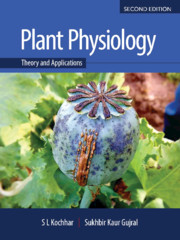Book contents
- Frontmatter
- Contents
- Foreword
- Preface to the Second Edition
- Preface to the First Edition
- Acknowledgements
- Some Common Abbreviations used in the Text
- Abbreviations for Units
- Unit I Water and Mineral Translocation in Plants
- Unit II Metabolism and Bioenergetics
- Unit III Growth and Development
- Unit IV Physiological Stress and Secondary Metabolites – Their Role in Metabolism
- Unit V Crop Physiology – An Innovative Approach
- Unit VI Breakthroughs in Plant Physiology
- Unit VII Some Experimental Exercises
- Glossary
- References
- Index
- Colour Plates
Chapter 2 - Absorption and Translocation of Water
Published online by Cambridge University Press: 12 May 2020
- Frontmatter
- Contents
- Foreword
- Preface to the Second Edition
- Preface to the First Edition
- Acknowledgements
- Some Common Abbreviations used in the Text
- Abbreviations for Units
- Unit I Water and Mineral Translocation in Plants
- Unit II Metabolism and Bioenergetics
- Unit III Growth and Development
- Unit IV Physiological Stress and Secondary Metabolites – Their Role in Metabolism
- Unit V Crop Physiology – An Innovative Approach
- Unit VI Breakthroughs in Plant Physiology
- Unit VII Some Experimental Exercises
- Glossary
- References
- Index
- Colour Plates
Summary
Absorption of Water
Water is the essential medium of life. Thus, Plants that are land-based (as opposed to aquatic ones) are faced with potentially lethal desiccation through water loss to the atmosphere. This problem is aggravated by the large surface area of leaves, that are exposed to high levels of radiant energy (sunlight) and their need to have an open pathway for CO2 uptake. Thus, there is a conflict between the need for water conservation and the need for CO2 assimilation.
The need to resolve this vital conflict determines much of the structure of plants that grow on land, namely: (i) the development of an extensive root system to absorb water from the soil; (ii) a low-resistance pathway through the tracheary elements to bring water to the leaves; (iii) hydrophobic cuticle lining the surfaces of the plant to reduce evaporation; (iv) microscopic stomata on the leaf surface to allow gaseous exchange; (v) guard cells to regulate the diameter and diffusional resistance of the stomatal opening.
Algae and simple land plants like mosses and lichens may absorb water through their entire surface but in the vascular plants, the absorption of water takes place mostly through the roots. The source of water supply, with few exceptions, is the soil. The principal source of soil water is rain.
Different types of water
• Run-away water (not available to the plant): After a heavy rainfall or irrigation, some of the water drains away along the slopes. This is called run-away water.
• Gravitational Water (also not available to the plant): Some of the water percolates downwards through the larger pore spaces between the soil particles under the influence of gravitational pull until it reaches the water table.
• Hygroscopic Water (again not available to the plant): Water gets adsorbed on the surface of soil colloids and held tightly by them.
• Chemically combined Water (again not available to the plant): A small amount of water is bound to the molecules of some soil minerals by strong chemical bonds.
• Capillary Water (the form that is available to the plant): The remainder of the water that fills the spaces between the non-colloidal smaller soil particles.
Capillary water plays a major role as it is readily adsorbed by the roots. The total amount of water held in the soil is called ‘holard’.
- Type
- Chapter
- Information
- Plant PhysiologyTheory and Applications, pp. 51 - 74Publisher: Cambridge University PressPrint publication year: 2020



